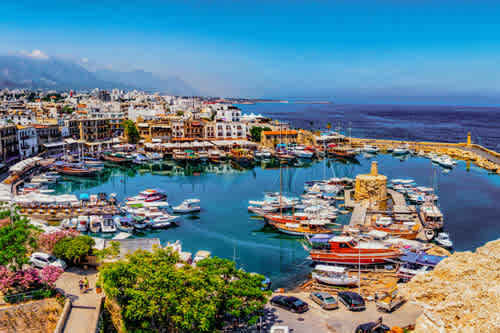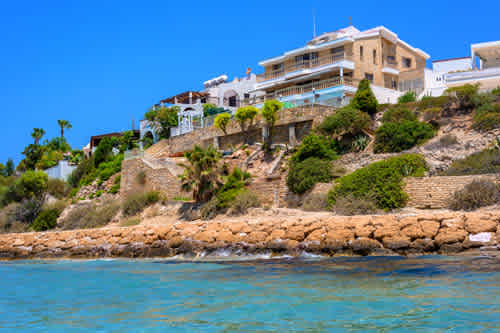About Cyprus
Situated in the heart of the Mediterranean, Cyprus is an attractive tourist destination that blends stunning beaches, rich history, and vibrant culture.
Situated south of Turkey and to the west of Syria and Lebanon, Cyprus is the Mediterranean's third-largest island. The island is divided into two main parts: the Republic of Cyprus in the south and west, and the Turkish Republic of Northern Cyprus in the north, with a buffer zone separating them.
Cyprus has a long and rich history that stretches back thousands of years. It had been part of various ancient civilizations, including Greece, Rome, Byzantium, and Venice. In 1960, Cyprus gained independence from British rule, but tensions between the Greek Cypriot and Turkish Cypriot communities led to the island's division in 1974.
The culture of Cyprus is a blend of Greek and Turkish influences, with each community preserving its traditions. Greek Cypriots primarily inhabit the southern and western parts of the island and speak Greek, while Turkish Cypriots reside in the north and speak Turkish. Each community has its own customs, cuisine, and festivals that contribute to the island's cultural diversity.
Here are some not-to-be-missed highlights of a visit to Cyprus:
Paphos Archaeological Park: A UNESCO World Heritage site, this park houses an impressive collection of well-preserved Roman villas decorated with stunning mosaics, ancient theaters, and a medieval castle. It is a sprawling open-air museum situated along the coastline near Paphos Harbor, which offers a glimpse into life in the late Roman period, as well as other ancient periods.
Tombs of the Kings: One of Cyprus's most significant archaeological sites, the Tombs of the Kings has been on UNESCO's World Heritage list since 1980. These monumental underground tombs, carved into rock, date back to the Hellenistic and Roman eras. Despite their name, these tombs were actually the final resting place for high-ranking officials and nobility. The grandeur and elegance of the tombs, adorned with Doric columns, highlight their significance.
Aphrodite's Rock: This giant rock formation on the beach, known as Petra tou Romiou, creates turbulent waves and foam. According to mythology, it's the birthplace of the goddess of love, Aphrodite, as she arose from the sea foam.
Kykkos Monastery: Nestled in the Troodos Mountains, this stunning Orthodox monastery houses a notable icon of the Virgin Mary and showcases unique frescoes and mosaic works. Today, the monastery produces a Cypriot brandy called "zivania" and other alcoholic beverages. Religious processions take place on September 8th (Birth of the Virgin) and August 15th (Dormition of the Virgin). The monastery's museum presents a rare collection of icons, manuscripts, and antiquities.
Ayia Napa: Situated along Cyprus's vibrant coast, Ayia Napa is one of Cyprus’s gems. Its exquisite beaches, vibrant nightlife, family-friendly water parks, and cultural landmarks make it a sought-after destination. Enjoy aquatic adventures such as water sports and boat excursions. There are several outstanding beaches nearby, including:
- Nissi Beach: One of Cyprus's most renowned beaches, Nissi Beach boasts soft white sand and clear turquoise waters, making it an ideal location for sunbathing and water sports. About 2 miles west of Ayia Napa's popular tourist hub, the long beach draws a diverse crowd and features a pristine coastline along with music, bars, and lively beach parties. Nestled within a natural bay, the calm and sheltered waters create a peaceful haven, forming part of the larger Nissi Beach area, named after the adjacent islet 'Nissi'.
- Fig Tree Bay: Nestled in Protaras, Fig Tree Bay stands out with its long sandy shoreline gently sloping into the sea, catering to both families and seasoned swimmers. Typically calm and clear, the waters are perfect for swimming, snorkeling, and other water activities. The bay derives its name from a solitary fig tree that once stood near the beach.
Limassol Castle: This medieval castle in Limassol houses the Cyprus Medieval Museum, which chronicles the island's history. Positioned near the ancient harbor, the castle holds historical significance. It is famously associated with the marriage of Richard the Lionheart and Berengaria in 1191 (though its original construction date remains unclear). The current fortress was rebuilt by the Ottomans in 1590.
The highest peak, Mount Olympus, reaches nearly 6562 feet, and along the way, you'll see ancient trees, diverse wildlife, and scenic pathways. The Troodos Mountains are renowned for their unique geology and rich copper deposits, and during the winter, the area is known for its winter sports and skiing. There are tourist accommodations in adjacent charming villages like Kakopetria and Platres, where local restaurants offer authentic Cypriot cuisine.
Larnaca Salt Lake: This is the second-largest lake in Cyprus and a hub for thousands of migratory birds, including flamingos, which can be observed during the winter. The lake's history dates back to the late Bronze Age, and a 2.5-mile nature trail offers a breathtaking walk to the old water mill of Kamares. Salt harvesting used to be a significant trade in Cyprus, with Larnaca serving as a major exporter.
Kourion Archaeological Site: An important ancient city, Kourion's archaeological site contains impressive remnants of its illustrious past. The Greek-Roman theater, meticulously restored and used for performances, stands as a testament to its grandeur. At the center of the site is a private villa known as the House of Eustolios, which was transformed into a public leisure hub, showcasing stunning fifth-century mosaic floors. Also present are a Roman agora surrounded by colonnades, a public bathhouse, and a Nymphaeum temple. An early Christian basilica and a separate baptistery add to the site’s historical charm.
Diving: Cyprus offers abundant diving attractions, and one particularly notable spot is the Zenobia wreck, ranked among the world's top 10 diving sites, located off the coast of Larnaca. The ship sank in 1980 and lies on its side, offering divers a unique view of the ship's structure and the cargo it carried.
Local Cuisine:
Halloumi: Perhaps one of the most renowned Cypriot foods, Halloumi is a semi-hard, salty cheese made from a blend of sheep and goat milk. Its distinctive texture makes it perfect for grilling, frying, or savoring fresh.
Souvlaki: A beloved street food, Souvlaki features marinated and grilled skewered pieces of meat (often pork, chicken, or lamb) served with pita bread, salads, and assorted sauces.
Meze: A delightful assortment of small dishes served as a satisfying meal or appetizer, the selection includes a range of culinary delights like hummus, tzatziki, olives, grilled vegetables, dolmades (stuffed grape leaves), and keftedes (Cypriot meatballs.
Kleftiko: A traditional Cypriot dish, Kleftiko is made from slow-cooked lamb or goat meat marinated with herbs, garlic, and lemon, and then baked in a clay oven. The result is succulent and packed with flavor.
Moussaka: Similar to its Greek counterpart, Cypriot Moussaka is a layered dish made with ground meat (often beef or lamb), eggplants, potatoes, and béchamel sauce.
Tava: A unique dish made with various types of meat (usually chicken or pork), tava is cooked with potatoes, onions, tomatoes, and herbs in a clay pot.
Stifado: A rich and flavorful stew, Stifado typically consists of beef or rabbit cooked with shallots, red wine, and a variety of spices.
Loukoumades: These delightful, sweet dough balls are fried until golden and then soaked in honey or syrup, often dusted with cinnamon or sesame seeds.
Baklava: Baklava is a delectable pastry created by layering thin sheets of phyllo dough with finely chopped nuts, followed by a drizzling of sweet syrup or honey.
Commandaria: This traditional Cypriot dessert wine is one of the oldest wines in the world, made from sun-dried grapes and aged in oak barrels.
Pasteli: This is a Cypriot indulgence made of sesame seeds and honey, sometimes with added almonds or peanuts.
Cypriot Coffee: Enjoy a cup of strong Cypriot coffee, similar to Turkish coffee, served with a glass of water.
Situated in the heart of the Mediterranean, Cyprus is an attractive tourist destination that blends stunning beaches, rich history, and vibrant culture. Whether you’re looking for relaxation or exploration – or a balance of both - the inviting shores, ancient ruins, delicious cuisine, and diverse landscapes of Cyprus offer an unforgettable travel experience.
Popular Itineraries
Traveled by thousands
Regions in Cyprus
Attractions in Cyprus
- Historic Center, Larnaca
- Historic Center, Limassol
- Historic Center, Paphos
- Town Center, Ayia Napa
- Historic Center, Nicosia
- Town Center, Protaras
- Historic Center, Kyrenia
- Historic Center, Famagusta
- Town Center, Polis
- Village Center, Pissouri
- Town Center, Paralimni
- Town Center, Pegeia
- Village Center, Oroklini











